They don’t make the great cars anymore.
Cars like the original (rear-engined/air-cooled) VW Beetle, for instance – which many consider to be the greatest car ever made, if the standard for greatness is a car almost anyone could afford to buy – and for that reason put almost everyone on the road who wanted to be on the road.
The Ford Model T was another, earlier example of the same kind of greatness differently expressed.
These cars weren’t fast or sexy but they were easy to get and cheap to keep. They didn’t ask for much beyond fuel, oil, brakes and tires once in awhile and they ran and ran and ran – and then ran some more. It was common to see them on the road as daily drivers 20 or 30 years after they were made.
Of course, you can’t get a new old Beetle or a Model T anymore.
But you can get what is arguably a car greater than either of them – combined.
What It Is
The Corolla is several things nothing else is.
First, it is the world’s best-selling car – large, small, whatever. Ever. More than 45 million of them have been stamped out since 1966, its first year on the market. That’s more of them than all the Model Ts and old Beetles produced – and added together.
It has also been on the market longer than any other modern economy car, encompassing the production run of once ubiquitous rivals like the Dodge Neon and Chevy Cavalier that came – and went.
Not being very great.
One often sees 20-plus-year-old Corollas still in use as daily drivers. The sight of a Neon or Cavalier that still runs is rare.
Like the old Beetle and the Model T, the Corolla isn’t sexy or speedy. But it has an unsurpassed reputation for being a sensible, easy to live with and exceptionally long-lived car that more than gives you your money’s worth.
Which is why 45 million-plus have bought one.
Greatness sells itself.
It is also one of a dwindling number of new cars – including economy cars – that still offers a manual transmission. Rivals like the Honda Civic sedan, the Nissan Sentra and the Mazda3 are automatic-only.
One of the few others in the Corolla’s class that offers a manual for about the same money is the N-Line version of the Hyundai Elantra, which also comes with a more powerful turbocharged engine.
Neither of the Corolla’s available engines are turbocharged – but this is among the reasons why the Corolla is a great car. A Corolla bought this year will probably be on the road 20-plus years from now because its engines aren’t turbocharged. Turbos are fun. More power is always fun. But they also add pressure – and that can lead to cost after 20 years on the road.
Or even sooner.
There are other Corolla virtues, too – including an AC/heater system (and stereo) you can adjust without tap/swipe/pinching a touchscreen and interior spaciousness very close to that of many mid-sized cars for the price of a compact-sized car.
The base trim Corolla L with a 1.8 liter engine and CVT automatic stickers for $20,025. An SE trim with a more powerful 2.0 liter engine and six-speed manual transmission stickers for $23,175.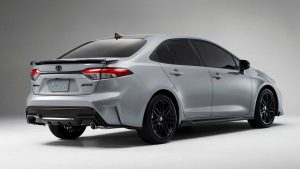
There is also a hatchback (and a hybrid) version, which will be reviewed separately.
What’s New
Probably in response to the new Elantra N-Line, Toyota has added an Apex package to the mix. It includes a firmer-riding suspension, lower ride height and the option to buy a set of high-performance short sidewall “summer” tires.
What’s Good
The car you’ll hand off to your kid 10 years from now – who will hand it off to his kid.
Available manual transmission; standard not-turbocharged engine.
Knobs that turn rather than icons you tap.
What’s Not So Good
Manual availability limited to SE trim.
Otherwise standard automatic is a CVT automatic.
CVT-equipped models come standard with ASS (automated stop/start).
All Corollas except the SE come standard with a 1.8 liter, 139 horsepower four cylinder engine without a turbocharger.
Or direct injection.
This engine is one of the few engines under the hood of any new car that still has port fuel injection only – so it doesn’t have multiple fuel pumps or operate at several thousand pounds of pressure and won’t carbon-crud the backsides of the intake valves, a problem with direct injected engines (crutched by adding a separate port-fuel injection circuit to keep the backsides of the intake valves clean).
It is not as powerful an engine as some of the engines that come standard in rivals like the Honda Civic (2.0 liters, 158 hp) and Mazda3 (2.0 liters, 155 hp) but if you are interested in an engine that’s simpler than almost any engine you can get in a new car – and for that reason more likely to be problem-free down the road – then you will probably be interested in this engine.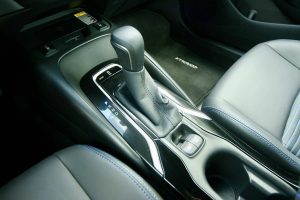
The bad news is that Toyota pairs it exclusively with a continuously variable (CVT) automatic, a type of automatic that has become almost unavoidable in new cars because it offers a slight fuel efficiency benefit – about 2-3 MPG is typical vs. a car with a conventional automatic – and while that is probably not a big deal to potential car buyers, it matters a great deal to car manufacturers as they try to “comply” with miles-per-gallon minimums that keep going up and up.
To illustrate the point: The Corolla with the 1.8 liter engine and CVT automatic rates 30 city, 38 highway – while the Mazda3 with the 2.0 liter engine and a six-speed conventional automatic rates 28 city, 36 highway.
But why is it bad news – assuming you don’t mind an automatic?
For two reasons, one subjective the other objective.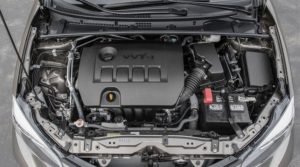
Subjectively, the CVT’s operating characteristics don’t appeal to some buyers. They do not shift through gears but rather transition through ranges, continuously varying – which is how they eke out the slight MPG advantage. But this lack of shifting can feel like the transmission isn’t working properly – or making the engine work hard.
With a conventional automatic, the transmission shifts up from first to second to third (and so on) as you accelerate. Engine speed (RPM) and noise reduce as you increase speed. With a CVT, the engine speeds up as you increase the car’s speed, the transmission holding the engine at higher speed (RPM) until you back off the accelerator. This can feel “busy” – and is sometimes noisy.
The other issue – the objective issue – is that CVTs in general haven’t proved to be as long-term durable as conventional automatics. Instead of a planetary gear set and hydraulic circuit – as in a conventional automatic – the CVT uses a metal band that expands and contracts to vary the range as you drive, to suit conditions and speed, etc. The problem there is that expansion and contraction of anything that’s metal tends to fatigue metal over time and when the band fails, the CVT transmission is kaput.
The good news is you can skip the CVT – by choosing the Corolla SE.
It comes with a six-speed manual transmission and a larger 2.0 liter engine that makes 169 horsepower without a turbo. It is almost as powerful as the Honda Civic’s optional 1.5 liter engine that does have a turbo – and which is paired only with a CVT automatic.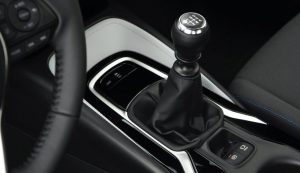
The SE Corolla’s mileage dips a bit, but not a lot: 29 city, 36 highway. This – as it turns out – is slightly higher than the turbocharged/CVT’d Civic’s 29 city, 35 highway.
Plus you get to shift for yourself.
The only other price-equivalent car in the class that lets you do the same is the N-Line version of the Hyundai Elantra . . . which has a turbocharged and direct-injected engine.
Will it be around 20 years from now? We’ll have to wait and see!
On The Road
Economy cars didn’t used to be boring cars to drive because most of them came standard with a manual transmission and that gave you something to do while driving. Which made the drive less boring. It also let you make the most of the engine you had, which usually didn’t make a lot of power – for the sake of being economical.
But with a stick, you can still have some fun in an economical car.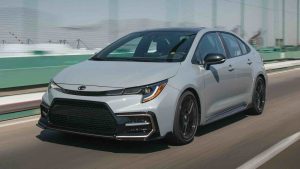
You can keep the revs up by holding a gear – or going down a gear. It’s enjoyable – if you aren’t asleep behind the wheel – to work the car and develop your skills. Which – when honed – can result in the best possible actual gas mileage.
Automatics (and CVT automatics) post higher mileage numbers but that is because they are programmed to deliver them . . . on the tests used to establish city/highway numbers. In the real-world, a person can out-shift the automatic – and even if not, there is a value in having more control over the car and having more fun driving the car.
The manual-equipped Corolla is a fun car to drive that is also a car you will probably still be driving 15 years from now. Or someone else will be driving it.
Speaking of driving it . . .
The Corolla has buttons and knobs to adjust the radio volume and tune stations; buttons and knobs to turn up (or down) the AC and heat. Which means you don’t have to take your eyes off the road while you’re driving to adjust these things – as in almost every other new car, most of which have smartphone-emulating touchscreen interfaces that you have to look at to adjust because you can’t feel an icon.
There is an LCD display inside the Corolla but it is unlike the others in that it is meant to be a display rather than an interface. There are even tactile buttons on the sides of the thing to get you to the correct menu, without having to “scroll” through “menus” or “swipe” or “tap” a screen with no feel that forces you to look.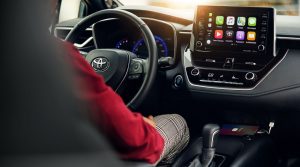
This by itself makes the Corolla a great car.
You will also like the ride – and the seats, which are magnificently not-too-firm and not-too-soft. Drive a Corolla for six hours straight and you’ll understand why this is great, too.
At The Curb
Part of the reason for the Corolla’s enduring popularity is its appeal to everyone. It’s not a guy’s car or a chick’s car or an old person’s car or a poor person’s car. The old Beetle had the same quality – without the amenities – which explains why it’s gone and the Corolla’s not. 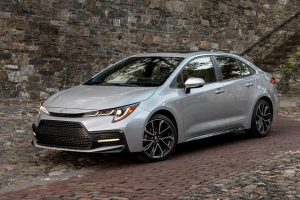
Although the Corolla is considered a compact-sized sedan, if you consider the key interior specifications, you will see it is an almost-mid-sized-car where it matters. There’s 42 inches of legroom in the front seat and 34.8 inches in the back; the actually mid-sized Camry sedan has 42.1 inches of legroom up front and 38 inches in the back – a difference of .1 inches up front and 3.2 inches in the back. The Corolla’s 13.3 cubic foot trunk is also only slightly smaller than the much larger (outside) Camry’s 15.1 cubic foot trunk.
Point being, the Corolla is big enough to be a family car, for much less than the cost of a not-much-larger car like the Camry, which stickers for $24,970 to start. The Camry is a very nice car, too. But it’s nice to not have to spend the almost $5k more to get one vs. the Corolla.
In addition to the practical controls for the stereo, AC and heater, the Corolla also comes standard with practical wheels – made of steel rather than aluminum – and they are fitted with low cost 15-inch tires, which will cost you less than the 16 and 17-inch wheels that have become common even in the economy car class, in spite of their being less economical both to buy and because they wear out faster and are more easily hurt by curb strikes and potholes.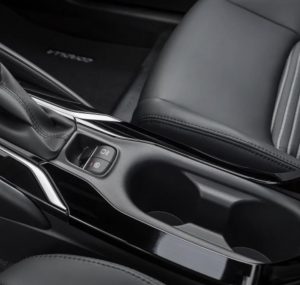
The standard L and LE trims also come with a keyed ignition – rather a key fob and a push-button ignition. The keyed ignition is likewise practical in that you can get a new key cut – as opposed to buying a new fob that must be programmed.
You can load up a Corolla with pushbutton ignition, heated seats, LED headlights and dress it up with the blackout trim that comes with the Nightshade package and even amp it up with the new Apex package that firms up the suspension, lowers the ride and increases the car’s lateral grip with a set of extra-grippy “summer” high-performance tires.
But at the end of the day, what makes this car great is that it doesn’t need any of that stuff to make it great.
The Rest
One of the few small things that’s not-so-great about the Corolla is the too-small cupholders in the center console, which could easily have been made larger. The center console itself being wide enough to accommodate larger cup holders.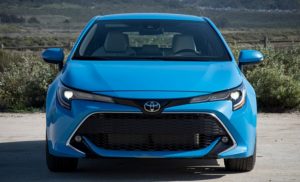
The other thing is that ASS is now standard in CVT-equipped Corollas. It’s another thing brought to you by the government, which Toyota has added as a way to “comply” with the government’s gas mileage and “greenhouse gas” strong-arming.
But this can be avoided by buying the manual-equipped Corolla SE. It is free of ASS, at least until they figure out how to integrate stop-start “technology” with a manual transmission.
Or just get rid of the manual transmission.
The Bottom Line
There are other cars that are better at this – or that. Stronger, faster – sexier – or more “high tech.” But there has never been a car that’s better than the Corolla at being a great car.
45 million – and counting.
It speaks for itself.
. . .
Got a question about cars, Libertarian politics – or anything else? Click on the “ask Eric” link and send ’em in!
If you like what you’ve found here please consider supporting EPautos.
We depend on you to keep the wheels turning!
Our donate button is here.
If you prefer not to use PayPal, our mailing address is:
EPautos
721 Hummingbird Lane SE
Copper Hill, VA 24079
PS: Get an EPautos magnet or sticker or coaster in return for a $20 or more one-time donation or a $10 or more monthly recurring donation. (Please be sure to tell us you want a magnet or sticker or coaster – and also, provide an address, so we know where to mail the thing!)
My eBook about car buying (new and used) is also available for your favorite price – free! Click here. If that fails, email me at EPeters952@yahoo.com and I will send you a copy directly!


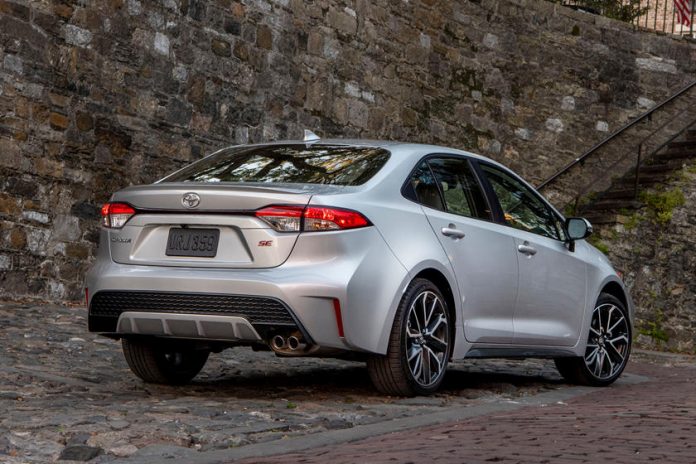











Some time ago, I brought our Sienna van in for maintenance- the big one at 90K. They gave me a corolla as a loaner. I drove the thing home, marveling at the fit, finish, and ride. It occurred to me that they put the same effort and care into building this lower end car to what they did on my Sienna, or the Camry I had at the time.
When I got home I turned to look at the window sticker – ~$12.5K. Thought to myself that had I bought this and made the trip home, I’d be smiling at the deal I got. I can’t say that about most of the American vehicles I’ve bought. With them, I was just to get out of the dealer with a car I could tolerate. One the wife wanted, not me.
I’ve had a 4runner and Sequoia, and drove toyota pickups for work. They outclass every similar sized truck out there. That said, I’ve had a camry and now a rav4. I tell people they are the homely girlfriends that can cook. Yeah, they don’t make your heart flutter originally, but after time you love them.
FWIW I had a 2000 deville at one point. I called that one the stripper chick with fake boobs.(and given what I spent on repairs, a coke habit)
I have some bad news. They already know how to put ASS in a manual.
I’m currently driving a 2020 Jeep Wrangler Unlimited with the 6-speed manual. It has ASS, but it comes with a button to shut its ASS off. I understand that an aftermarket programmer can be used to keep ASS out of the way by exploiting a software hole in ASS, but it requires a device be constantly plugged into the OBD-II port because it has to regularly smack the virtual ASS off button in software.
I got the V6 and manual for much the same reasons that you speak of here. The rest of the vehicle is relatively basic and straightforward, too.
I would like a lame bouque of “features”. I don’t have a cell phone other than a flip thing that I had to use ten times to report on a trip to eastern Montana. I bought another one recently that is a three year old Nokia which is likely unconnectable in a car system.
Hey, what ever happened to the car phone as seen on MANNIX? Do I care?
What annoys me is that my wife just pissed away 40k on a Honda van and it doesn’t have a compass unless you pay 4k more for the “Navigation System”. My wife is my navigator on the rare trips that we have. She carries an atlas of Wisconsin for neural analog navigation. I have had to turn around to get the atlas more than thrice because she feels a sense of dread without it. Now I ask if it is included in all of her junk as it is a conversation along the way. There likely is no room for maps in the glovebox anymore, and I don’t give a darn about cup holder sizes.
Hi Erie,
The only useful (to me) amenity my ’02 Frontier lacked was a decent stereo capable of piping music through itself via Buetoof. So I put one in for less than $200. I don’t need – and don’t want – a touchscreen, much less any “advanced driver assistance technology.” I can handle that myself!
OK Eric, I looked around on the dealers that are relatively close to me for a manual and there is nothing that I can find, just as other makes on the low end that have a manual. Where do you find a review car that is similar to the one that you got for review?
Hi Erie,
This problem comes up a lot – the problem of dealers not stocking the base trim (or, as in this case, the one with the manual transmission). Ask them to order one for you. If they won’t, tell me – and I will be happy to tell Toyota about a dealer of theirs that won’t sell a customer the car he wants to buy.
You might try looking on Autotrader for one with a manual. That’s how I found my manual Jeep. You can pick various options there and a search radius that will search all dealerships within that radius. That way you can see where the closest car is.
Incidentally, an added benefit not mentioned of a manual transmission is you can often get a much better deal on one. Since few people today know how to drive a manual, those cars tend to sit on lots a long time and the dealer is desperate to move them, often at a steep discount. I managed two grand under invoice on a Rubicon that sat on their lot for six months, likely because it was a manual with few options.
Your reply is most welcome. I have a 2011 CTS-V coupe with a manual. It is sitting in the the snow that is melting, but my twice hand down 2003 Mercury van is not what I want anymore. I thought that it would be useful as a telescope hauler except my vision has gone to hell. I would like to have a small car but with a manual that inspires lesser habits than can be done with a damned CVT that migh as well be a super good EV that may go 180 miles on the rollers of the testers. As an aside, who has to pay for all of these goomint testers that have ruined automobiles?
I could go on with my experiences with goo but I will get profane.
Any company invaded by these imbeciles must demand any and all proof of whatever they claim to be, including the address of their domicile. Then once entry they must fill out the form to verify the gender of the goomint invader.
Then they must retract their immunity fom local laws just as the mask crap from them.
This might be the last chance to get a knob for pushing the shift.
Is it controlled “by wire”.
Oh Eric what do you have to say about manuals that attempt to match down shift speeds?
It is a most good thing that Toyopet has nothing at all in the entire midwest that compares to your test drive.
Hi Erie,
The “rev matching” function is meant to electronically emulate the manual double clutch maneuver, which few can perform as it’s a fading art form. It makes the car feel racier, I suppose – and in a race situation, it could make the difference. But for a street driven car, I consider it more needless complexity (more to eventually cost you money) for little real-world gain.
Eric, do you reckon the 2.0 liter engine with the manual transmission could pull a small teardrop camping trailer? Asking for my kid sister.
I am not Eric, but it is fashionable in Australia to use small cars to tow small caravans and utility trailers. That was 40 years ago but is still done today and more so due to the higher power output of small 4 cyl motors. My fil had a late 70s manual Corolla that he used to tow such equipment, except the caravan was a box shape and quite heavy. So tow away to your heart’s content.
Hi Mack,
Toyota doesn’t rate the Corolla to tow anything, so keep that in mind as far as warranty considerations. That said, I wouldn’t worry about pulling a small trailer that weighs no more than 1,500 pounds and ideally, less. If your sister is going to do this, I advise halving the scheduled service interval for the tranny fluid and would consider having an accessory transmission fluid cooler added, along with an accessory temperature gauge.
I actually liked my wife’s cast off Ford Escort wagon as it was the best winter shitbox that I have had. It did an average of 29 mpg highway towing 1000 pounds of junky fishing boat across the state to the mighty Mississippi. I did it when the river was in flood and can recoe that staying far upstream from the dam is prudent.
I don’t care about A/C as windows down works well enough for a motorcyclist that never had air conditioning. I do like electric windows so one does not have to reach the roll knob on the passenger side.
I will get into a wreck if I have to mess with the stupid touch screen.
As you might surmise that I am looking for the least amount of electronic crap.
You have sold me to an extent, and you have my e-mail to forward to Toyopet so that you can get credit for the sale. The blue is fine with me.
Oh, and it has to be the manual.
Hi Erie,
I expect you’ll be happy with this car; it’s the one I’d buy if I were in the market for a superb transportation appliance that’s also a superb little car.
Do not bother as there are no manual midwest USA cars without CVT/ASS.
I still think that Mister Eric makes up his junk.
Hi Erie,
If your local Toyota store won’t order the car with a manual, contact other dealers. If they won’t order the car with a manual, contact Toyota directly. I assure you the car is available with a manual and without ASS. The fact that a given dealer hasn’t got one in stock isn’t surprising given that most people seem to want an automatic. But it does surprise me that a dealer would turn away a buyer over this.
Inexpensive, sustainable, common sense transportation while not requiring this
https://arstechnica.com/cars/2021/03/biden-pushes-ev-chargers-as-six-utilities-plan-a-unified-network/
I’m with you Eric, I enjoy running errands in my 5-spd Miata.
In this case, engagement is wonderful.
I slave around in Europe, so I could never figure out that american attraction for automatic transmission!
One has to acknowledge that japanese know how to build good low maintenance long lifespan vehicles.
I bought a new Toyota back in 2002 never had a problem with the car. I’ll only stop using it when, while driving, the wheels fall off or when the jesters and scoundrels in government declare “gasoline cars are forbidden” and one day the copigs make me stop and steal the car!
I don’t even know if it was sold in the US since it does not need too much gasoline for travelling!
Toyota Yaris Verso 1.3
Hi Voz,
The Yaris was sold in the U.S. for awhile; it was dropped because small cars – as in really small cars – don’t generally do well here, even if they are good cars. Americans can indulge larger cars because gas is cheaper here – though of course that is in the process of changing.
The Corolla strikes a balance between too small – and too expensive. I can’t say enough about it and – trust me – I’m pretty uninspired by most modern cars!
I bought that Yaris Verso (not a regular Yaris) mainly due to SIZE!
I’m 6ft 6in tall so cars with reduce Head space and very low sitting position are a no go for me. It also has a maximum volume load that beats most light vans.
Indeed they don’t make great cars anymore. It seems they are making a multimedia room and just add the wheels!
Crazy how many Corolla’s Toyota has sold over the decades. There is a reason Toyota is the world’s largest car maker. They make their cars to last. These things must be easy to work on, and the parts plentiful. It is nice they offer a manual. If you had to have the CVT only, it isn’t the end of the world. Toyota’s CVT’s are built much better than Nissan’s crap Jatco CVT’s I bet. You also have to be good about doing regular fluid change intervals on the CVT. I think Toyota even has a new design CVT that incorporates a 1st gear for getting the car moving. Seems pretty brilliant to me.
Recently my 87 y.o. father “retired” from driving and gave me his 2013 Toyota Corolla…which, in eight years, he’d only put 24K miles on. Seriously. I was tempted to keep this little jewel, it’s about as stripped down as that car gets…does have air, and automatic, a “boring” beige-sorta color, but it’s cheap to run. However, I’ve already got a 2020 Ford Fusion which is a bit more “comfy” on the highway, while the Corolla is great for buzzing about town. So…it’ll go to my “little goil” when she’s done with her Mormon mission later this year, and she goes to college in “Yew-Tah”. I figure that kid can “girl it up” and still, IF she takes care of it, drive that car until she’s THIRTY, so it’ll be a good way to indirectly help her out with her education.
‘It speaks for itself.’ — EP
‘Res ipsa loquitur,’ as Romans used to say (and lawyers still do).
Back in 1960, Toyota shipped some prototype vehicles to southern California in an attempt to crack the big American market.
It didn’t go well.
Their puny engines couldn’t keep up with traffic on those legendary L.A. freeways. Their crappy little 12-inch lawn mower tires wobbled and blew out. Farther inland — Death Valley way — radiators boiled over in the pitiless desert heat.
Chastened, Toyota’s engineers made their way home, toting suitcases of notes, for a total rethink.
A certain obsessive aspect of Nipponese culture came into play. These are people who made flower arranging and tea ceremony and the spare decoration of tatami rooms into elaborate art forms. Years can be spent shaping a banzai tree or seasonally varying the wavy lines raked into a gravel garden.
Ten years of practice, it’s said, leads to mastery. At Toyota, distilled into kanban (lean manufacturing) and kaizen (continuous improvement), earnest practice meant that by 1970 its vehicles could compete in the US market with no loss of face.
To this day, Toyota cars and pickups sell at a noticeable premium in the used car market. Res ipsa loquitur.
Jim you must be speaking of Nissan, then Datsun. They did the exact same way of entering the US car market. Read a book called “The Turning Point”. A book about Ford and Nissan covering all aspects of their respective corporations. Jim Halberstrom is the author.
My car to learn in was a Datsun 1600, MGB competitor.
On my test drive with the DMV drone it started to run roughly. I pulled over and told him that it lost a cylinder. I left it running and got quite the shock to put the cap on the plug. I embarrassed myself and shut it of for the few seconds to seat the plug wire caps. We continued with the driver test with the top down and I rather think that he enjoyed it as compared to the tubby sedans with a slushbox that was the usual.
You know how it is in having a drone being able to deny the “driving privilege” at sixteen.The guy was pretty decent and complimented on analyzing engine function knowledge, so wrote me up as a PASS.
There is nothing better than having a two seat with ragtop down to prove one’s ability.. Using the gearbox for almost maximum effect on down and up sorta impressed him. It must have been a change from a road test with a Ford-O-Matic.
I hate automatics that continually hunt for a gear on normal flat driving. I want a manual so that it can all be blamed upon me.